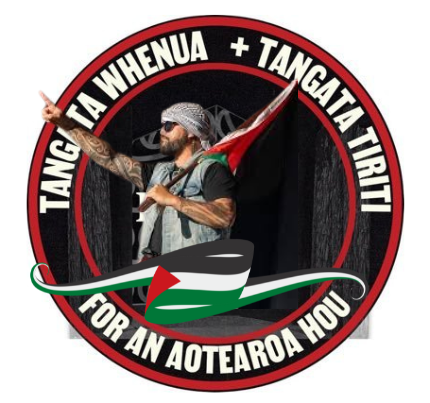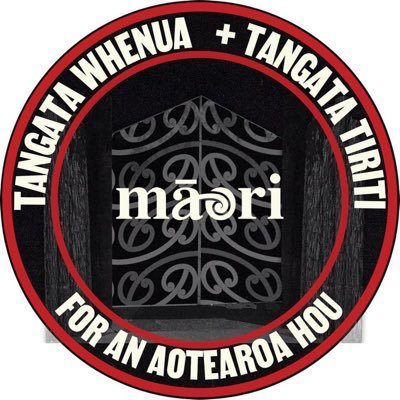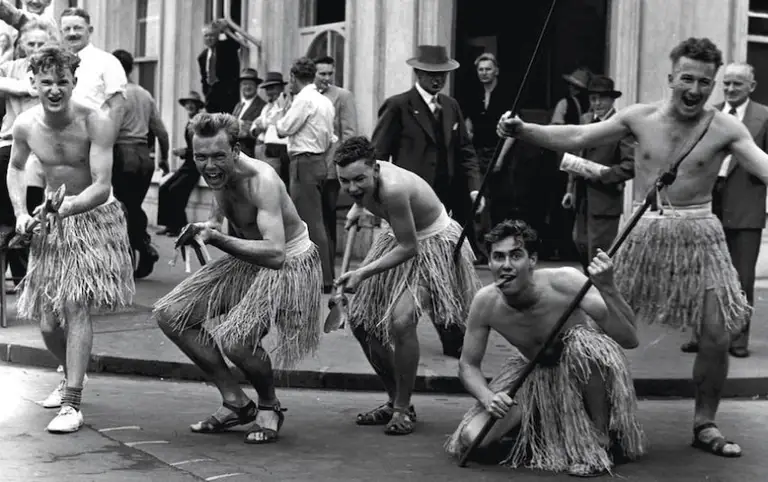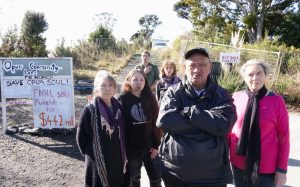
An innovative piece of theatre has resurfaced a long forgotten story with a lasting effect on race relations in New Zealand. Simon Day spoke to director Katie Wolfe about The Haka Party Incident.

New Zealand is full of racism, from your uncouth uncle to the systemic institutional racism of New Zealand’s justice and education systems. We’re often unwilling to acknowledge it, or don’t recognise it. For example, last week a talent and modeling agency put a call for “all Māori, gangster looking type people.” They probably didn’t intend to be racist, but the fact they believe ‘Māori’ and ‘gangster’ are mutually inclusive is highly problematic.

Earlier this month, for three nights, an innovative piece of verbatim theatre told the mostly forgotten story of when a challenge to Pākehā New Zealand’s casual racism to Māori ended in violence, and changed the landscape of race relations in this country. The Haka Party Incident is documentary as live theatre. It reexamines the moment in 1979 when activist group, He Taua, attacked a group of engineering students as they rehearsed their annual mockery of the haka.
For 20 years Māori had written to the engineering school at Auckland University asking them to stop an annual event where students would dress up in grass skirts and perform the university haka ‘Akarana’ as a capping day lark. By the 1970s it had morphed into a grotesque mimic, where the engineers would draw penises and curse words on their body – a caricature of tā moko – get very drunk, charge around the university causing chaos, and stop traffic up and down Queen Street to perform the haka.
But in 1979 a new generation of activists were emerging. They’d watched their culture suffocate beneath colonialism and then the urbanisation of Māori, and had seen generations of passive resistance get crushed by force. They’d had enough. The activists went to the university that day to demand the engineers stop their “tradition”. But in a room full of frustration, masculinity, and anger this demand was served with fists.
There was an uproar. The activists were reported as “gang members” by the media; they were held and questioned brutally by police and charged with a number of offences including rioting. But for perhaps the first time in New Zealand what was initially labelled as “a bit of fun” was finally perceived for the institutional racism it was. A three minute fight in a university common room came to represent a deep challenge to the perceptions of New Zealand society as fair and tolerant. And it became the platform for people like Hilda Halkyard (later Halkyard-Harawira) and Hone Harawira to demand better for Māori in New Zealand.
This important piece of history was almost forgotten; it was tagged a regrettable incident that got hidden away. The Haka Party Incident uncovers the story through the voices and perspectives of those who were in the common room that day. New and old interviews are performed, word for word, by the actors, sometimes while a historic interview is projected on a screen above the stage. It retells the story with the inconsistencies and subjectivity of memory and nearly 30 years past. It shows the fear He Taua had of losing their culture, their anger at being mocked, and the ignorance and arrogance and regrets of the engineers. And by performing the memories, the play gives life to a story that was almost forgotten.
The performance of The Haka Party Incident is the first episode in a dynamic piece of work that will grow as director and creator Katie Wolfe (Ngāti Tama, Ngāti Mutunga) tracks down more characters and adds their memories to the layers of the story. So far the story focuses on those who were in the university common room the day the violence occurred and the perspective of AUSA president Janet Roth. Wolfe wants to speak to more of the engineers, representatives of the university, the media and those involved in the court case that followed. The play will also become a documentary film. Wolfe spoke to The Spinoff about reviving the story, and what racism looks like in New Zealand – then and now.
If you were part of the haka party story and its fallout and would like to contribute to the project contact Katie Wolfe at katie.wolfe@me.com.

I’d never seen verbatim theatre before. It looked and felt like documentary but it brought it to life. Is that what it is designed to achieve?
I’ve never made verbatim theatre before, I am a great admirer of it, but it was a punt to put history into that platform. Ostensibly it is documentary. You could listen to the haka party incident as an audio file. There is an audio file that exists, that is played into the actors’ ear, that we created during the rehearsal process, which is an incredibly complex thing to do. We only did it in seven days, the whole piece. For many of those audio files I filmed the interviews as well. It could just exist as a normal documentary.
But the idea of it being a performance is you get that moment where there is a connection with the audience. And that connection is why we still do theatre, how potent it is to have humans in the same room together. We live in such a digital age. The idea that there were performers on stage, connecting with an audience, made it more tangible.
You use the word living… one of the main of themes in the piece is racism, and that is something we should always be talking about.
Why the haka party incident? What was it about that story that drew you to it?
When I read about it, which was in Ranginui Walker’s book a good 15 years ago, it just struck me that it was this moment where Māori and Pākehā met in a moment of violence and that seemed to me significant. That had to be significant.
Once I started reading more around it, it became more and more interesting: what is this crazy haka party thing that they did? Why and where did it come from? And the people involved in He Taua, and who they were and the amazing work that these people did in that time of the 1970s. They were the vanguard pushing through to the Māori renaissance of the 80s.
In the blurb for the Auckland Theatre Company I called it “the last New Zealand war”, which is a cheeky way of talking about it. That was the leaping off point.
Is it fair to say the story has been lost?
Absolutely. When I pitched it to the Auckland Theatre Company, not one person in the room had heard about it. I asked the actors in the two weeks coming up to rehearsals to ask anyone they randomly met in their daily lives if they had had heard of the Haka Party incident, of those five actors they came across one person. So it is a story that has become completely forgotten.
What you saw was the first forty minutes of the show, of the story and the court case is the last chapter, and the Human Rights Commission [decision] that came out of it. Part of what I am going to go back into is why this story got forgotten. I have only spoken so far to the people who were in the room that day, the engineers, He Taua, and of course Janet Roth. On their behalf there was some forgetting as well. Especially from the engineers, they wanted the story sort of tucked away. The university wanted the story tucked away and forgotten.
For He Taua, the fruits of their protest didn’t emerge until five years later, so I think there was a feeling of futility immediately afterwards. And of course they got a lot of flack within their own Māori communities about it. There was an act of forgetting there again.
And also the media tucked it away as well because there was a feeling in 1979 that we were a very nice country. I read a lot of newspapers from around that time. I didn’t use any media in the play at all. But initially when the story was first reported it was like: “Gang rampage through the university.” It was nicely tidied away with a story about how the Māori Club and the engineers got together and had a beer at the Kiwi Hotel and everything was forgiven and everyone moved on. So there was absolutely no investigative energy put towards why it had happened at the time in the media. It was nicely tied up, and “that happened, and let’s just forget about that, and everyone is going to get along fine again, and just move on.”
Across all those things, everybody wanted to forget about it. It happened, it was forgotten about. And of course we don’t teach our history in our schools.

What does the loss of that story mean for those who fought to reestablish te reo Māori, and the place of tikanga Māori in New Zealand?
When I met Hilda, especially Hilda, she was the one who instigated it. And of course she opens the play with that incredible piece of footage I found that was shot by Stewart Main, where she is just crying saying she could see very clearly that we, as Māori, were at the absolute brink. That she knew. There was no language regeneration. There was poverty. There was huge trouble with Māori adjusting to life in the cities. And of course the ramifications of the devastating loss of land.
And I remember when I first met Hilda, for the first interview, I just gave her this huge mihi, and thanked her profusely for all the work she had done in her life. Without people like her, goodness knows where we would be. Because they weren’t at the time hugely supported. They were getting massive amounts of flak from Māori at time. They were being told to sit down, don’t make trouble. A lot of elders in iwi were trying to work through government and official channels. They were not only pushing against a Pākehā society, they were also pushing against a very conservative Māori framework as well.
Hone and Hilda talk about how they’ve been labelled these protesters and trouble makers. But they have dedicated their whole lives, and are still working, towards their goals.
All the members of He Taua actually. Miriama (Rauhihi), whose speech is in the last part of the play, where she says: “I will never stop fighting spiritually, emotionally, and physically, I will fight until the end of my life.” They are all incredibly dedicated to the kaupapa, and I think should be celebrated because of that. But they are virtually unknown. And I hope the play, and one day the film, will go some way to getting that story out there.
How did that moment, that incident become an important part of everything that came after? It must have been really hard for He Taua to face down critics from both sides , but for it to lead to the rejuvenation of Māori must have been validating?
Yeah it must have been. I know for Hilda, she had to go back to university. She said to me that following year, she just kept her head down, she was finishing her degree. The Māori club at the time, there was a very delicate balance going on. What isn’t in the play, and what someone in the audience talked about, was how conservative university was. They were the ones who were sanctioning the ridiculous tradition of the haka party to go on.
Then there was the Springbok Tour, and a lot of people connected with Ngā Tamatoa, and He Taua was involved in that, and a lot of them went to jail around that time. In a way, the Springbok tour was another kaboom moment that happened.
There was an utter tenacity to keep pushing.
How was the haka party incident linked to partnership and the Treaty?
There seems to be a massive gap in understanding what partnership is, in terms of understanding why the haka party was institutionalised racism. It easy to say it was because you were disrespecting the haka, but actually it’s wider than that in that it was not entering the concept of partnership, which is understanding that there is difference. And being bothered to understand what that difference is.
The fact that letters had been written every year for 20 years to the engineering students asking them to stop doing the haka was horrifying. The violence was a shocking part of the incident, and I hate to advocate for violence, but they must have felt like something active had to be done for any change to happen.
It was coming out of Bastion Point as well. Māori protest right up to that point was absolutely walking in the footsteps of the prophets and passive resistance. On Bastion Point it was passive. Every person who was dragged off the point went passively. For some I could feel it, when they talked about it, speaking to Hone [Harawira], speaking to James [Pasene], it didn’t feel like they were getting anywhere.
The frustration was building up, and building up, and it actually came out on that day. I think it is clearly established, they went there not intending to have a fight, but I think there was frustration at absolute boiling point. When that moment happened: “you take those fucking skirts off,” and that guy went “get fucked”, it was a powder keg.
How long did it take for the haka party performance to be acknowledged as racist by the majority of New Zealand?
In the media there is a lot of talk about it being racist, but in the media it was absolutely one side or the other. It was either: “this is ridiculous, it’s nothing more than a bit of capping day fun, and goodness gracious can’t we laugh at ourselves and have a bit of fun.” The other side was “this is racist and it must it stop.” There was this huge gap, there was nothing between the two attitudes.
You heard the engineers talking about how they still don’t really consider it racist, because they weren’t racist with intent. There is this thing we talk about in the play – the kūare, or the ignorance, of what is racist. Some people probably still don’t see it as that. It is very obvious to other people. The people who hadn’t seen or known about the haka party when they saw the images of the guys in the grass skirts, some friends were incensed by it. They couldn’t believe that went on.
I think the questions of when did they know it was racist, I don’t think you can pinpoint a date. I think it is a continuum thing. The one thing I learned by doing the show, I always approached the concept of racism as something that must not exist in society and we must work against it, but actually I think racism will always exist. It is something in our nature to be afraid of difference.
There are attitudes if you are in the minority that have a really detrimental affect on your life. In terms of racism it is something we need to talk about all the time. Because I don’t think it will ever go away.
Do you think New Zealand is racist place today?
I think New Zealand has a unique mixture of wonderful tolerance and inevitable racism.
I am a very strong advocate that te reo Māori must be offered to every child in this country from the age of five in school. Whenever that idea is put out there, I often read the comments [giant sigh]. People seems to be so against it – they think there’s no use for it, they think it will affect their children’s education. I think we still have a lot of work to do in that sense.
But I also know when that happens children will love it, they will flock to it. I think the language is a real turning point for helping understanding across cultures.
Unfortunately, the voice of intolerance can be very loud sometimes, and the media like to jump on it to.
Thinking of what racism looks like in 2017, the images of a casting call for “gang types” and specifically requesting Māori looking people, it reminded me of the play because He Taua were so upset by being labelled gang members. It was such a poor portrayal of who they were and what they were there to achieve. How does it make you feel to still see Māori stereotyped today?
I always go, who is doing this? Because it is in our industry. It is tapping into massive stereotypes. Back in the ’70s that was the stereotype of Māori – violent thugs, getting into brawls. So I see things like that and it comes from ignorance. The person whose job it is in the casting agency has not got the education to understand that what they are doing is racist.
It exists still, it exists. It shows that racism is a continuum. Stereotypes exist everywhere. Women are always pushing through stereotypes in storytelling as well. For me it is very important that you call people out on that stuff.
The play is a living breathing piece, so what’s next for The Haka Party Incident?
More Reading
- Attempts to break the world record for the biggest haka, reviewed and ranked
- Students end rent strike, but call for further action
- The future of Aotearoa is entwined with the future of Māori
There are two things that are happening – one, I keep pushing and develop it into a full length theatre piece which includes the court case. So the next people we speak to, because I’ve only spoken to those people who were in the room, is the university, the people around the university. And of course on the He Taua side, the people who were around He Taua, in Ngā Tamatoa, and in the activist community. And those who were not in the activist community and were not supportive of He Taua. And those closely associated with court case. One who was Sian Elias, who was fresh out of Stanford and working in a practice in Grey Lynn. I think I am going into the media. The media is quite interesting in how it was portrayed.
Also, there is Tim Shadbolt. He apparently gave a really influential speech in the quad, and he turned it around. Anyone who had got up and spoke in favour of He Taua were booed off the picnic table and couldn’t get a word in. Apparently Tim did a really incredible speech, and appeared to be on the side of the engineers and then flipped it. I am looking forward to speaking to Tim and seeing if he can remember anything about it.
It’s widening the circle out in terms of the story. And everything I have gathered will be archived and made into a film. I am going to seek some support from the Film Commission to finish that off.





